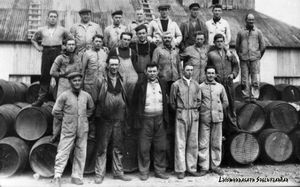100 years of fish-meal and -oil processing
Iceland's first plants to process fish-meal and -oil were set up in 1911 by Norwegian entrepreneurs. In the following decades, dozens more were built around the coast of Iceland – first by foreigners, later by Icelanders. The herring fishery has often been called Iceland's first industry. The capacity of the plants rose to thousands of tons a day, and when catches were good they yielded huge profits for their owners. The herring fisheries (producing salt herring for human consumption, fish-meal and oil) sometimes accounted for nearly half of Iceland's national income, and so herring (Clupea harengus) came to be known as the silver of the sea, or Iceland's gold. The little fish capelin (Mallotus villosus) too has made for big export revenues.
But unpredictability is the very essence of the fisheries – and never more so than in the case of the migratory herring.
In 2012, Herring Museum employees Örlygur Kristfinnsson and Anita Elefsen launched an exhibition about the 100 year history of the fish-meal and -oil industry in Iceland. The exhibition is presented in fifteen displays and is now part of the exhibition in Grána and also, the exhibition has traveled around the country.
The exhibition was opened on Midsummer Night in June 2012. A symposium was held in Grána and covered diverse topics. Among the speakers were Historian Guðni Th. Jóhannesson, Ichtyologist Guðmundur Óskarsson and Jón Reynir Magnússon, former Executive of SR, the State-run factories.
The Herring Era Museum would like to thank the sponsors of this exhibition: the Association of Icelandic Fish Meal Producers, Eyþing Cultural council, The Cultural council of East Iceland and the Icelandic Marine Research Institution.
Below are several examples of some of the historical displays from the exhibition 100 years of fish-meal and -oil processing.
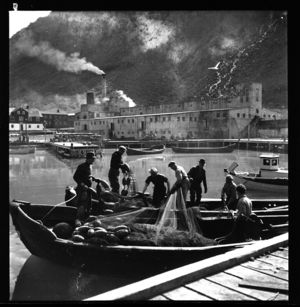
In remote Djúpavík bay in the northwest of Iceland, a herring plant was built in 1934-35. It was one of the largest in the world, and regarded as a state-of-the-art factory. After two seasons in operation, the factory was debt-free, and it operated profitably until 1954, when it closed down due to lack of fish.
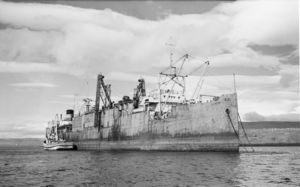
Huge catches of herring in Hvalfjörður in 1946-7 led to the purchase of a state-of-the-art rendering vessel, Hæringur, from the USA. The 7,000-tonne ship had a capacity of 10,000 barrels of herring per 24 hours. But this ambitious project did not live up to expectations: by the time the ship was sold to Norway in 1954, it had rendered only 13,850 barrels of herring over a period of four years, and its debts had quadrupled.
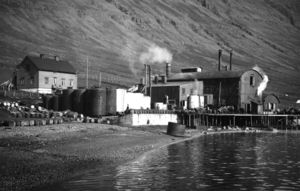
In the 1950s new rendering plants were opened in many locations in the East Fjords. In the early 1960s, when the herring's migration route shifted to the fishing grounds off the east coast, these plants flourished as the powerhouses of the Icelandic fish-meal and -oil industry. At that time the herring plants of the north of Iceland were in decline, and one after another they went out of business. Plants operated in 14 places in the East Fjords. The photo above shows the Paul-factory in Neskaupstaður.
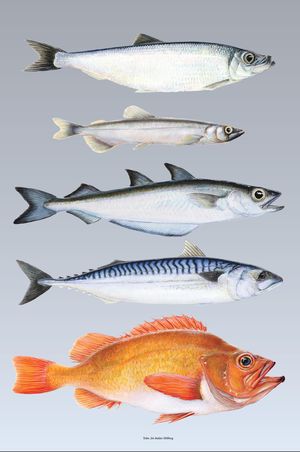
What species are processed into fish-meal and -oil?
Atlantic herring, Clupea harengus (25-38 cm), is the fish species which has been caught most for rendering in the northern region. It is the most important species in the history of fish-meal and -oil processing in the northern hemisphere. The Icelandic fishing fleet's catches have fluctuated from 50,000 tonnes to 650,000 per year.
Capelin, Mallotus villosus (13-20 cm), has been an important commercial species for Iceland since the collapse of the herring stocks in 1968. Annual catches have fluctuated from 50,000 tonnes to 1.2 million.
Blue whiting, Micromesistius poutassou (30-40 cm), was first caught by Icelanders in the ocean southeast of Iceland in 1972, but initially catches were small. This species was caught in larger quantity after 1995, peaking in 2003 at 500,000 tonnes. Catches have since declined, and are now about 100,000 tonnes. The blue whiting is of the cod family, and not a good source of oil.
Mackerel, Scomber scombrus (30-40 cm), has been caught since 2006 off the east and southeast of the country. For the first few years most of the catch was rendered, but this soon gave way to processing for human consumption. Iceland's mackerel catch has risen from 4,000 tonnes in 2006 to between 110,000 and 150,000.
Redfish or ocean perch, Sebastes marinus (33-42 cm), was caught in some quantity by Icelanders off Newfoundland in the mid-20th century. Some of the catch was rendered, but in recent decades the entire catch has been processed for human consumption.

